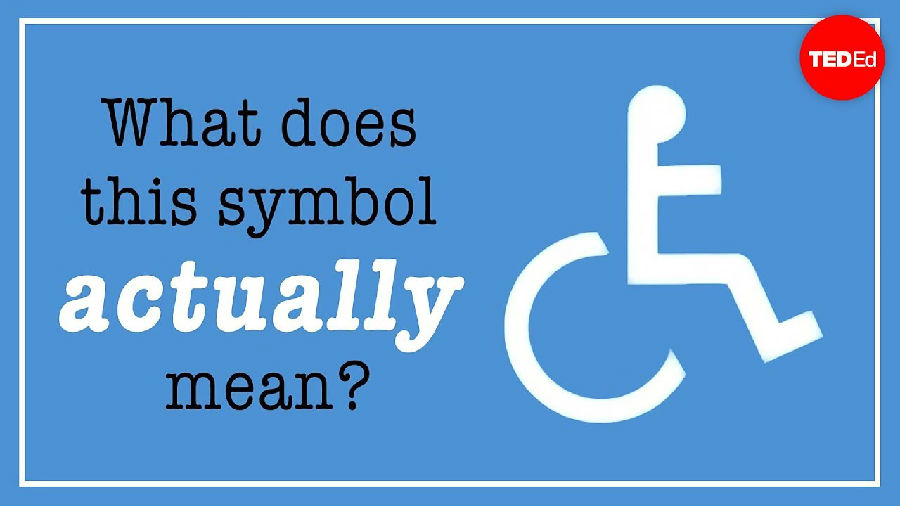(单词翻译:单击)
Some of the world's most recognizable symbols exist to sell products, others to steer traffic or advance political causes.
世界上最具有辨识度的标志,一些是为了销售产品而存在,另一些是为了引导交通,还有一些是为了推进政治。
But there's one whose main purpose is to help people.
不过,有这样一个标志,它的主要目的是为了帮助人们。
You may know it as the wheelchair symbol, or a sign for people with disabilities,
你或许认为它是轮椅标志,或是残疾人标志,
but its formal title as maintained by the ISO is the International Symbol of Access.
不过,它被ISO(国际标准化组织)确认的正式名称是“国际无障碍标志”。
But despite its familiarity, many people are unclear as to what the symbol actually means,
尽管人们对它很熟悉,大部分人其实并不了解这个标志的真实含义,
which has a lot to do with the symbol itself and the way it came about.
而这个标志的含义与其本身及其由来有密切的关系。
In 1968, the International Commission on Technology and Accessibility held a design contest.
1968年,国际技术与可及性委员会举办了一个设计大赛。
They were looking for a symbol that would be readily identifiable from a reasonable distance,
他们在寻找一个标志,一个在合理距离内易于识别的、
self-descriptive, simple, practical, and couldn't be confused with existing signage.
自我描述性强的、简单的、实用的、不会和现存标志混淆的标志。
The winning design, which didn't have a head, was created by a Danish designer named Susanne Koefed.
丹麦设计师Susanne Koefed的设计获得了大奖,而这个标志起初并没有脑袋。
The addition of a head a year later gave it a more human form,
一年后这个标志被加上了脑袋,使得它更加类似人类的形态,
and within ten years, it was endorsed by both the United Nations and the ISO.
在十年内,它被联合国和国际标准化组织认可了。
With minimal cost and minimal fuss, a global icon was born.
在最小成本和最少争论的情况下,一个国际标志就这样诞生了。
There have been a few tweaks over the decades.
几十年间,这个标志也曾经历过一些变动。
The Graphic Artists Guild added more rounded, human-like features,
图形艺术家协会给它加上了更加圆润的、拟人的特征,
and in 2012, the Accessible Icon Project produced a more dynamic version.
而在2012年,“无障碍标志项目”制作了一个更加生动、富有动态的版本。
But what does it really represent? What's its purpose?
但它到底代表着什么呢?它的目的到底是什么呢?
Put simply, it's a sign to identify where there are accessible facilities.
简单来说,这是一个指示无障碍设施位置的标志。

The strength of such an internationally recognized image is that wherever you travel,
这个国际认可的标志的好处在于不论你在哪里旅行,
you don't need to speak the language or have in-depth cultural knowledge.
你都不需要会说当地语言或懂得深厚的文化知识。
If you require an accessible toilet, the sign shows the way.
如果你需要一个无障碍厕所,这个标志就会将你指引到那里去。
But the confusion comes from the term accessibility and what that actually means.
但是令人困惑的地方,就在于这个“无障碍”和它到底意味着什么。
Many people assume that because the symbol depicts a wheelchair,
许多人认为,因为这个标志有一个轮椅,
that accessible facilities are meant only for people who use wheelchairs,
那么无障碍设施就是为使用轮椅的人群专门准备的,
or those, at the very least, who have a visible physical condition.
或者至少,是为了那些具有显而易见的残疾的人准备的。
But accessibility is a broad concept that applies to many, many different conditions.
但是“无障碍”其实是一个非常广的概念,它能够被应用到很多很多不同的情况下。
That includes people with autism, visual impairments, and autoimmune diseases,
包括自闭症人群、视力障碍人群、自身免疫性疾病人群,
like lupus, which can cause pain and fatigue, along with many other conditions.
例如狼疮,一种会引起疼痛和疲劳的疾病,还有很多其他的情况。
In fact, the World Health Organization estimates that
事实上,根据世界卫生组织的估算,
there are approximately 1 billion people who experience some form of disability,
世界上有近十亿的人有着某种形式的“残疾”或者“障碍”,
which means that this group is very likely to include yourself,
也就是说,这一人群中很有可能也包括了你,
or a family member, a classmate, a friend, or a work colleague.
或者是你的家人、你的同学、你的朋友、你的同事。
And people who use wheelchairs only make up about 65 million, or 15% of the total.
而使用轮椅的人群只占其中的6500万,或者说,总数的15%。
The vast majority have non-visible disabilities.
绝大多数人的“残疾”和“障碍”是看不到的。
Accessible parking spaces, facilities, and entrances are designed with that entire group in mind.
无障碍停车位、公共设施和入口,其实是为了这一群体而设计的。
So it's easy to see why in recent years people have begun to raise questions
所以显而易见,为什么近年来有人开始质疑
about whether the symbol is really appropriate for what it's meant to do.
这个标志是否真的与它代表的意义相符合。
And it's not just about accuracy.
这不仅仅是关于精确性的问题。
It's common for people to become indignant, sometimes abusive, when they see people without visible disabilities using accessible facilities.
对人们来说,看到没有显而易见的残疾的人使用无障碍设施的时候会感到非常愤慨,甚至会因此骂人。
The symbol is unfortunately creating widespread issues for the very people and families it's meant to help.
很不幸的是,这个标志正在为那些它本应服务的人群和家庭制造各种各样的麻烦。
The recent redesigns have attempted with some success to acknowledge concerns over the current symbol.
最近一些对这个标志的重新设计已经引起了对现行标志的思考和担忧。
But some think that a complete redesign is in order. It's a difficult task, though.
不过,有些人认为这个标志进行彻底的改头换面是必要的,尽管这会是一个非常艰巨的任务。
How do you replace a symbol that's familiar the world over? And what do you replace it with?
你要怎样替换掉一个已经被全世界所熟知的标志呢?还有你应该用什么来替换它呢?


